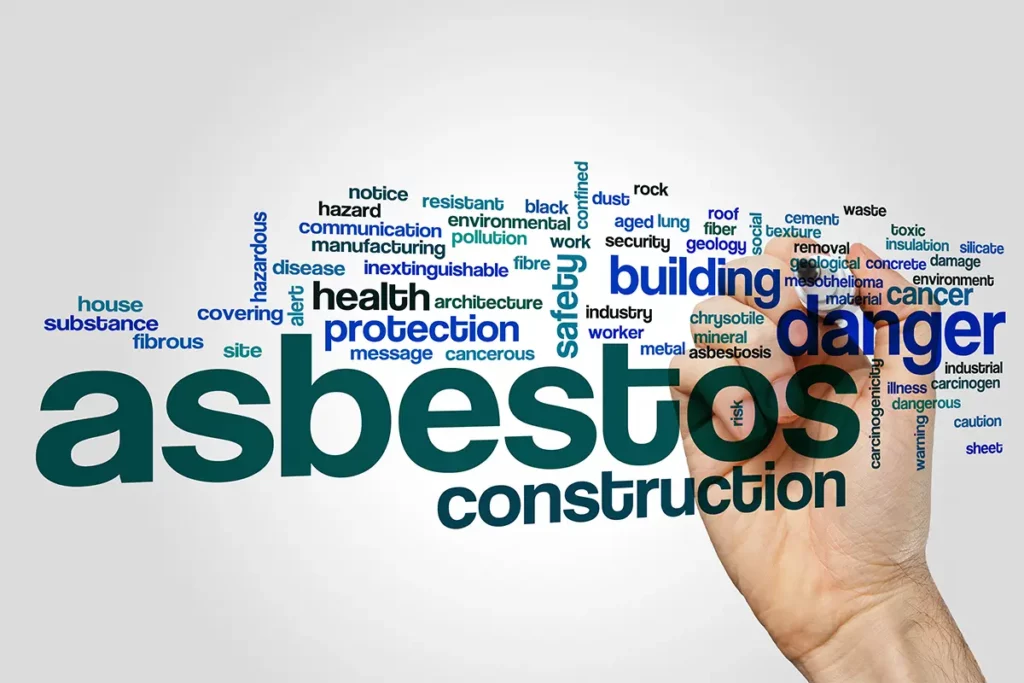Dealing with asbestos is one of the most stressful challenges for housing providers. We often encounter asbestos abatement issues, and educating owners on the laws is a challenging part of our job.
Mismanagement can put your tenant and property at risk. It’s important to be aware of the relevant asbestos laws concerning rehabbing and repairing your property.
We will unpack what asbestos is, where it comes into play most commonly for housing providers, and how to properly handle it to limit your risk and protect your tenants.
What is Asbestos?
Asbestos is a naturally occurring mineral renowned for its durability and resistance to heat and chemicals, making it a popular choice in building materials. However, exposure to asbestos fibers can cause serious health issues as it is a known carcinogen and can cause severe respiratory problems.
Asbestos was commonly used between 1928 and 1977 to make lighter building materials stronger and more durable. California experienced significant growth during that same time, and many properties were built using asbestos.
While asbestos was banned in California in 1977, asbestos should be a consideration for all properties built before 1981. Some experts believe that properties built between 1985 and 1989 should also be included in the threshold for testing. Despite California’s ban on asbestos, homes constructed after 1989 may have asbestos as some imported products may still contain the harmful mineral.
Fun Fact
The state rock of California is asbestos. Well, not really; it’s serpentine, a metamorphic rock that can contain chrysotile asbestos, the most common form of asbestos. Who would have thought that we’d be working so hard to ensure the state rock of California stayed out of California properties?
Asbestos is harmful, now what?
The government, schools, property managers, and homeowners have adopted “Manage in Place” strategies to control asbestos problems for decades. This means if the material is undisturbed or undamaged, it’s not necessary to remove it. Asbestos materials are often adequately contained within walls or covered by sealants.
However, unexpected events such as floods, fires, or mishandled home improvement projects can release asbestos fibers into the air. This contaminates the environment and presents a danger to occupants. Therefore, California has implemented strict regulations to ensure the proper handling, removal, and disposal of asbestos-containing material (ACM).
Regulations on Asbestos Handling
Cal/OSHA standards state that any disturbance of asbestos-containing material must be conducted by trained and certified individuals. Minor disturbances (under 100 square feet) may have more lenient requirements, but interpretation and local regulations vary.
Asbestos regulation falls under two main authorities:
- Local Air Quality Governing Bodies: These include AQMD (covering Orange County, Riverside, LA, and San Bernardino) and APCD (covering San Diego).
- OSHA: The Occupational Safety and Health Administration oversees workplace safety standards, including the handling and removal of asbestos. If you are the homeowner doing work on your own property, this agency is less of a concern, but it governs businesses like contractors and property managers.
There are also three main sources for the regulations surrounding asbestos in California:
- San Diego APCD Rule 1206: This rule applies to buildings with five or more units. It requires asbestos testing before any renovation or demolition, regardless of the building’s age.
- AQMD Rule 1403: Housing providers must conduct an asbestos survey before starting any repair or renovation work to identify asbestos-containing materials (ACM)
- Cal/OSHA Regulations: These regulations enforce strict handling procedures for asbestos. Only certified professionals are allowed to conduct asbestos-related work to ensure safety and compliance.
The Single-Family Home Exemption
APCD Rule 1206 does not apply to single-family homes unless they have a granny flat; it only covers buildings with five or more units. In pre-1980 single-family homes, plumbers might perform emergency repairs, but they must follow OSHA guidelines, including safety steps as:
- Containing the area
- Wearing PPE
- Wetting the material to limit dust
- Sealing the cavity after repairs
- Properly bagging, sealing, and testing the material
If asbestos is present, it must be disposed of according to Cal/OSHA and EPA regulations. Always test for asbestos before any repairs, or immediately after emergency repairs.
It’s important to note that even if your property is exempt from San Diego APCD Rule 1206, you must still comply with Cal/OSHA regulations for asbestos handling. Testing is crucial. Non-compliance can result in significant fines and legal trouble if a tenant files a complaint.
Let’s take a closer look at how the regulations regarding asbestos in California impact the testing and removal of asbestos.
Testing
It’s near-impossible to detect asbestos fibers with the naked eye. California regulations require a licensed professional with specialized equipment to attempt to detect and report on the presence of asbestos. Their findings are then sent to a laboratory where future testing is conducted to determine the type and concentration of asbestos. These results will confirm whether or not a property is dangerous.
As a rental property owner, if your property is deemed dangerous, you have two options:
- Hire a professional to remove the asbestos.
- Use sealants to contain the fibers.
Before your property undergoes renovation or demolition, California law requires testing for ACM. So, if you’re planning a renovation to your rental property, include asbestos testing in your plan.
Emergency Repairs
In some cases, testing for asbestos during a repair project is not required. In true emergencies, immediate repairs without prior asbestos testing are sometimes allowed, although it is best to conduct testing whenever possible.
When you experience a water leak or have another situation where you need to disturb drywall or demolish material where asbestos may be present, and your home is built before 1985 in most cases, you are required to test for asbestos.
Regulations on Asbestos Abatement
California outlines specific regulations when it comes to asbestos abatement and removal. These regulations are meant to minimize the exposure risks to the workers handling the removal process.
There are four classes of asbestos operations. No matter which class your project falls under, workers are required to wear respirators and protective clothing.
- Class I: Removal of asbestos from furnace and ductwork insulation.
- Class II: Removal of asbestos-containing floor tiles, wallboard, sheeting, roofing, and other construction materials.
- Class III: Involves repair or maintenance work, but does not permit the dry cutting of asbestos-containing materials.
- Class IV: For employees performing maintenance or custodial work who don’t disturb the material.
Class I and II must operate in an enclosed, regulated space to mitigate the risk of spreading the ACM.
Discovering Asbestos in Your California Property
You discover a water leak in the wall of a pre-1985 house, and the plumber needs to cut into the wall to repair it. The plumber might:
- Make the repair without testing: If it’s an emergency (delaying the repair would cause significant damage or health risks) and disturbs 10 square feet or less of material, they may proceed without immediate testing. However, most plumbers will not cut drywall without an asbestos test.
- Require asbestos testing: If it’s not an emergency or involves more than 10 square feet, testing is needed first.
In the first scenario, homeowners often fail to comply with the law, putting themselves at risk. Even if the repair qualifies as an emergency, proper asbestos handling and disposal procedures should be followed.
Best Practices for Landlords Dealing with Asbestos
Some common scenarios will require property owners to deal with potential or confirmed asbestos cases.
Immediate Steps for Leaks
If you have a leak in your property, these are the steps you must take:
- Ensure the area is safe and limit exposure to suspected asbestos materials.
- Contact a certified asbestos professional for a survey if more than 100 square feet of material is disturbed.
- If you have to take any emergency steps, document the situation, noting the urgency and risks.
Communicating with Owners and Tenants
Frustrations often arise when repairs cannot be completed immediately due to the required asbestos testing, which can take 1-3 days.
- Clearly explain legal and safety requirements.
- Provide information about Rule 1206 and the need for asbestos testing and abatement.
- Keep all parties informed about the repair timeline and safety steps.
Using Certified Professionals
While you often have a choice of who you choose to work on your property, when it comes to asbestos handling, you must always hire accredited asbestos professionals for testing and abatement to ensure compliance and safety.
For more detailed information, you can refer to the full text of Rule 1206 on the San Diego APCD website.
Property Management is Easy with Good Life
At Good Life Property Management, we believe life should be enjoyed, not spent sweating the small stuff. That’s why we set out to make property management easy. We take care of everything from finding the right tenants to maintaining your property—all while staying up-to-date on new laws that affect how you run your rental property.
We care about you, your property, and your tenant. And we do it all so you can Live the Good Life.
Schedule a call to speak with one of our Good Life experts.
Asbestos Laws in California FAQS
Are landlords required to disclose asbestos in California?
In an effort to protect tenants and give them all necessary information beforehand, landlords in California are required to disclose asbestos, lead-based paint, and pest issues to prospective tenants.
What are the asbestos laws in California?
Some regulations govern how asbestos is handled in California. The Cal/OSHA standards state that disturbances of over 100 square feet of Asbestos-Containing Material (ACM) with a concentration above 0.1% must be conducted by trained, certified professionals.
When did California stop using asbestos in houses?
The use of asbestos was banned in California in 1977. However, houses built between 1930 and 1950 may still contain asbestos in the insulation, textured paint, and patching compounds that were used on wall and ceiling joints.
Steve Welty
Subscribe to our Weekly Newsletter
Join the 5k+ homeowners receiving Local Law Updates and Landlord Tips. Delivered to your inbox every Saturday at 6am PST.
Share this:
Get in touch with us:
We make owning rental property easy.
Choose Your Next Step
Good Life Blogs
We believe that education is empowering.

Essential Tips for Preparing Your Property for the Rainy Season
There’s a famous quote that we hear often, ‘In this business, by the time you realize you’re in trouble, it’s too late to save yourself.”
As the rainy season approaches,

A New Playbook for Today’s Best Leaders: A Conversation with David Cuthbert of Wine to Water
Good Life CEO Steve Welty meets with the CEO of Wine to Water, David Cuthbert. They discuss leadership tactics and team dynamics.

4 Tips to Keep Great Tenants
Keeping great tenants in your property can save you thousands of dollars and make your experience as a landlord much easier.







